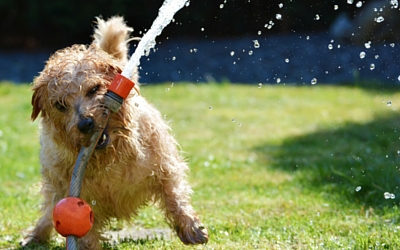
During the long, hot, ‘dog days of summer’, it is important to pay attention to just how hot our pets can get in extreme heat, and make sure we are aware of the signs they show if they are getting overheated or dehydrated. Pets can easily get heatstroke and dehydrated during the extremely high summer temperatures, which can be very dangerous for them.
Heatstroke is commonly used to describe hyperthermia, or, an elevated body temperature. A dog’s normal body temperature should not exceed 103°F or 39.4°C. Body temperatures above 106°F (41°C) without previous signs of illness are most commonly associated with exposure to excessive external or environmental heat. The critical temperature where multiple-organ failure and impending death occurs is around 107°F to 109°F (41.2°C to 42.7°C). A cat’s normal body temperature is slightly lower; around 100°F ( 37.7°C) , with 103°(39.4°C) being elevated and over 105°(40.5°C) being potentially life-threatening.
Dogs and cats are prone to heatstroke or overheating, because they don’t sweat, except through their paws and noses. They primarily cool themselves through panting. The most common cause of heatstroke for pets is being left in a car with inadequate ventilation on a warm day. In a hot car with poor air flow, an animal’s body temperature can rise rapidly and quickly become hazardous to their health. Pets should never be left unattended in a car during the summer months, even with the windows down. Parked cars can quickly reach deadly temperatures, even in the shade and with windows open. It only takes a few moments for an animal’s body temperature to rise dramatically and put their well-being at risk.
Other common causes for both cats and dogs are being left outside on hot days without any shade or access to water. Excessive or vigorous play or exercise during hot temperatures can also lead to heat stroke. Dogs with restricted airways, such as flat-faced breeds like pugs, boxers and bulldogs are at risk, as well as dogs that are muzzled, as the muzzle restricts their ability to pant. Short-faced cat breeds like Persians are similarly at risk, as is any pet who is older, very young, has a medical condition or is overweight.
Early warning signs of overheating are excessive panting and drooling, with a bright red tongue, and acting sluggish, confused, or in obvious distress. They can quickly progress to coma and even death if steps are not taken to reduce their body temperature. If your pet seems to be getting overheated, use cool water to wet them down (but not with ice or ice water, as that can cause their body temperature to drop too quickly). Make sure they have access to fresh air and cool drinking water. Heatstroke can lead to organ failure and death if not treated right away. If heatstroke is suspected, promptly get your pet to the veterinarian for medical attention. Heatstroke is an immediate medical emergency, and may need to be treated with IV fluids and oxygen.
Some ways to keep your pets cool during hot summer days are:
- Tie a wet bandana around their neck
- Get a kiddy pool for your dog to splash in (your cat too, if they’ll go willingly!), set up a sprinkler, etc. for them.
- Set up a fan or window air conditioner for your pet to lay in front of
- Make sure your pet has access to shade and fresh water outside
- Install a doggy door, so your pet can come in and out as they please
- Make sure your pet has access to a cool area of the house; do not confine them to an area that can get very warm, such as a sunroom.
Dehydration can also be a risk for pets during the summer, and linked to heatstroke if they are not provided sufficient free access to cool, fresh water. When there is not enough water in the body, fluid shifts out of some of the body cells, leaving those cells deficient of proper fluid, which also becomes a dangerous medical condition in need of veterinary attention. Always make sure all animals have access to fresh, cool drinking water, and providing additional access to water for cooling themselves, like a kiddie pool or sprinkler, can also help to keep up their fluids and maintain a safe body temperature. Keeping a watchful eye on your pets during hot summer days for signs of overheating, and taking steps to ensure they are able to stay cool and well-hydrated will help to mitigate the chances of having to make an emergency trip to the veterinarian for heatstroke or dehydration this summer, and allow everyone to enjoy summer to the fullest.